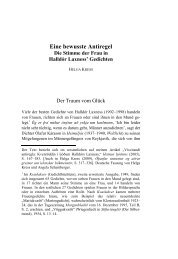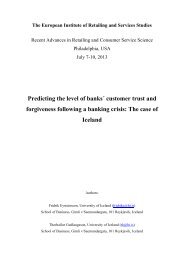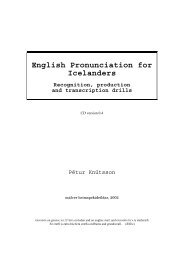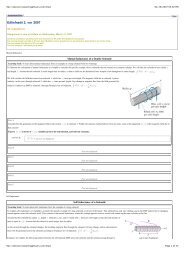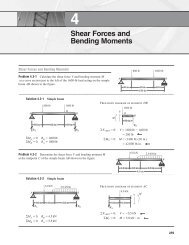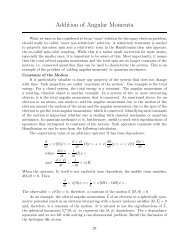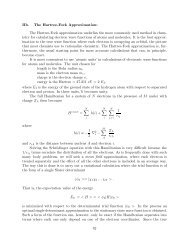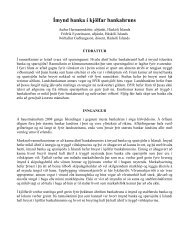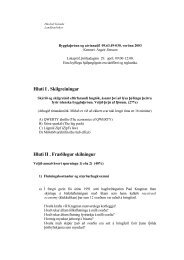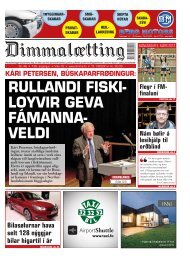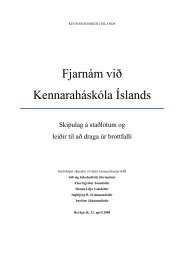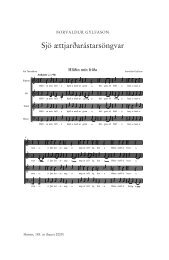Eðlisfræði 2, vor 2007
Eðlisfræði 2, vor 2007
Eðlisfræði 2, vor 2007
Create successful ePaper yourself
Turn your PDF publications into a flip-book with our unique Google optimized e-Paper software.
http://session.masteringphysics.com/myct<br />
04/19/<strong>2007</strong> 05:02 PM<br />
Kirchhoff's loop law defines voltages only in terms of fields produced by charges (like ), not those produced by changing magnetic fields (like ). So if we wish to continue to use Kirchhoff's<br />
loop law, we must continue to use this definition consistently. That is, we must define the voltage<br />
alone (note that the integral is from A to B rather than from<br />
B to A, hence the positive sign). So finally, , where we have used and the definition of .<br />
Part E<br />
Which of the following statements is true about the inductor in the figure in the problem introduction, where<br />
is the current through the wire?<br />
Hint E.1<br />
A fundamental inductance formula<br />
Hint not displayed<br />
ANSWER: If is positive, the voltage at end A will necessarily be greater than that at end B.<br />
If is positive, the voltage at end A will necessarily be greater than that at end B.<br />
If is positive, the voltage at end A will necessarily be less than that at end B.<br />
If is positive, the voltage at end A will necessarily be less than that at end B.<br />
Part F<br />
Now consider the effect that applying an additional voltage to the inductor will have on the current<br />
grounded). Which one of the following statements is true?<br />
already flowing through it (imagine that the voltage is applied to end A, while end B is<br />
Hint F.1<br />
A fundamental inductance formula<br />
Hint not displayed<br />
ANSWER: If is positive, then will necessarily be positive and will be negative.<br />
If is positive, then will necessarily be negative and will be negative.<br />
If is positive, then could be positive or negative, while will necessarily be negative.<br />
If is positive, then will necessarily be positive and will be positive.<br />
If is positive, then could be positive or negative while will necessarily be positive.<br />
If is positive, then will necessarily be negative and will be positive.<br />
Note that when you apply Kirchhoff's rules and traverse the inductor in the direction of current flow, you are interested in<br />
gives a term .<br />
, just as traversing a resistor<br />
In sum: when an inductor is in a circuit and the current is changing, the changing magnetic field in the inductor produces an electric field. This field opposes the change in current, but at the<br />
same time deposits charge, producing yet another electric field. The net effect of these electric fields is that the current changes, but not abruptly. The "direction of the EMF" refers to the<br />
direction of the first, induced, electric field.<br />
Mutual Inductance of a Tesla Coil<br />
A long solenoid with cross-sectional area and length is wound with turns of wire. A shorter coil with turns of wire surrounds it.<br />
Part A<br />
Find the value<br />
of the mutual inductance.<br />
Hint A.1<br />
Part A.2<br />
Mutuality<br />
Find the magnetic field of the solenoid.<br />
Hint not displayed<br />
Part not displayed<br />
Hint A.3 The flux in coil 2<br />
Hint not displayed<br />
Hint A.4<br />
Finding the mutual inductance<br />
Hint not displayed<br />
Express your answer in terms of , , , , and .<br />
ANSWER: = Answer not displayed<br />
Energy in Inductors and B-Fields<br />
Energy Stored in an Inductor<br />
The electric-power industry is interested in finding a way to store electric energy during times of low demand for use during peak-demand times. One way of achieving this goal is to use large<br />
http://session.masteringphysics.com/myct<br />
Page 3 of 15



